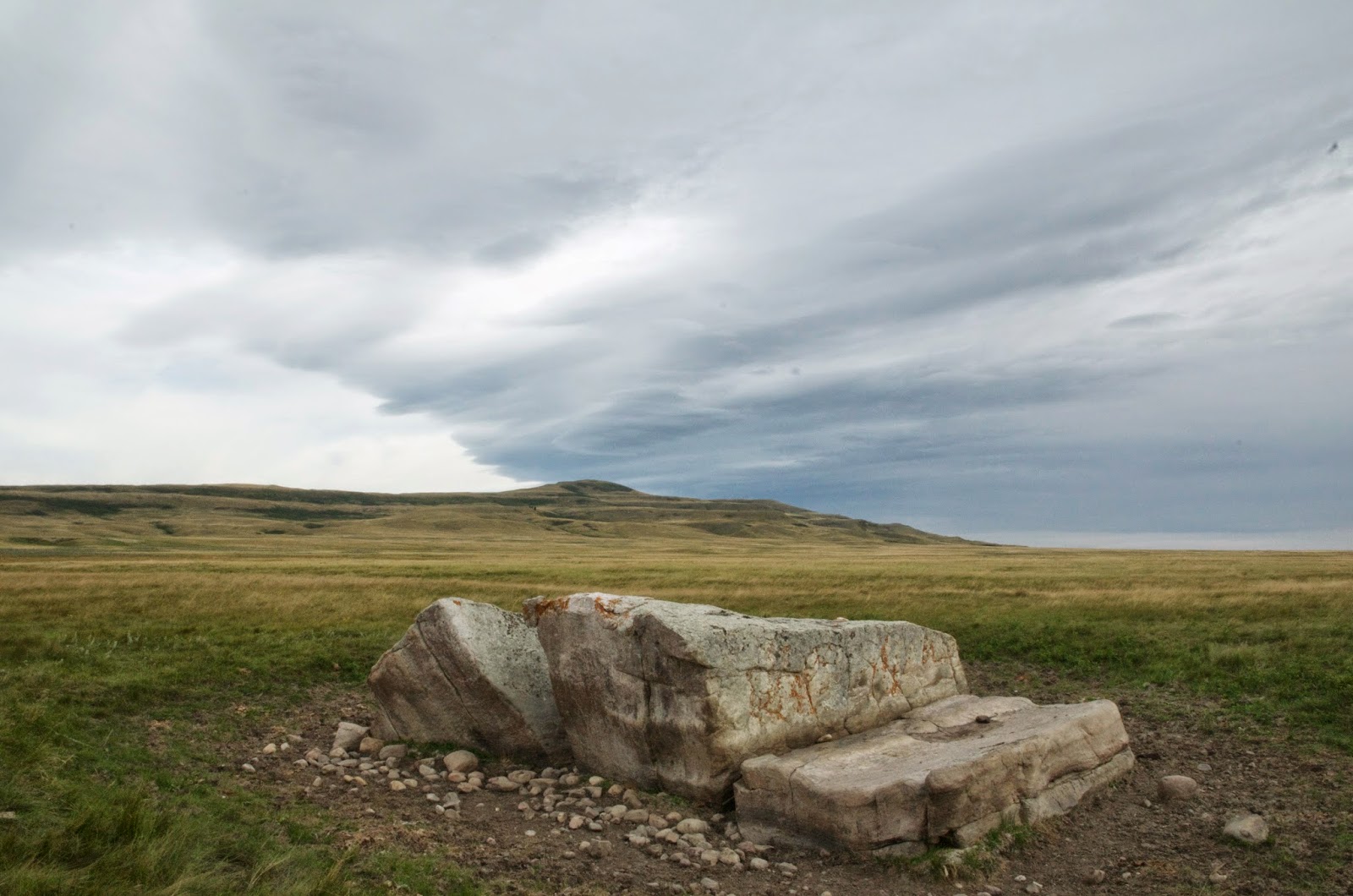It must have been
quite the sight to see; scores of charging bison tumbling off a 10 meter cliff
to their death. This flood to the senses happened at Head Smashed In Buffalo
Jump annually over the past 6000 years until the total depletion of Bison by
1860 or so. There are other buffalo jumps scattered throughout the west but
this one is well preserved and has a spectacular visitor centre/museum hosted
by local Blackfoot native people. This is also a World Heritage Site that is
visited by thousands of people annually.
We walked the paths and trails at the base of the cliff on the main killing ground. The native campsite would have been placed upwind away from the odours and out of sight of the charging herds. There is a small spring and shallow coulee at the cliff base where water would have been available for drinking, cleaning and boiling fat from bones. This mass slaughter would have been a gruesome sight, even cruel by today’s sensibilities, but was a life giving necessity then. Bison provided food, clothing, shelter and tools for the Blackfoot people. A successful hunt was a time for celebration, much like our own Thanksgiving celebration. A bountiful harvest assured everyone’s survival for the coming year.
 |
| Imagine Buffalo Pouring Over This Cliff |
We walked the paths and trails at the base of the cliff on the main killing ground. The native campsite would have been placed upwind away from the odours and out of sight of the charging herds. There is a small spring and shallow coulee at the cliff base where water would have been available for drinking, cleaning and boiling fat from bones. This mass slaughter would have been a gruesome sight, even cruel by today’s sensibilities, but was a life giving necessity then. Bison provided food, clothing, shelter and tools for the Blackfoot people. A successful hunt was a time for celebration, much like our own Thanksgiving celebration. A bountiful harvest assured everyone’s survival for the coming year.
 |
| Bison Skull |
The native people
planned this hunt for weeks in advance and it took place in the fall of each
year. The cooler temperatures would have helped to preserve the meat and the
bison hides would be prime and fully furred in preparation for winter. Cairns
of stones and brush would be strategically placed, like a giant funnel, along a
well planned route designed to force the bison to the cliff. Runners, wearing
wolf skin robes would slowly begin to move the herd using the bison’s own
protective nature and tendencies to herd together to combat danger. Soon the herd
was moving faster and gathering together and then breaking into a run. Native
men converged from the sides to prevent escape from the cairn dotted runway and
quickly an all out stampede was happening. Dust billowed from churning hooves,
calls and bleats of cows and calves trying to stay in touch, coughing,
grunting, horns clicking and hooves rumbled over the prairie landscape to the
cliff brink. The front runners tried to stop but were pushed on by the rest of
the herd, over the cliff. Most would have been killed outright but some of the
last would have only been maimed. Hunters based at the cliff base used arrows,
rock clubs and spears to finish any wounded buffalo. An awful silence would
then have descended over the valley as the enormity of the event was absorbed.
Then began the
work of butchering with skinning, gutting and dragging carcasses away for
further processing. When separated the carcass would be de-boned and meat cut
into strips to hang on drying racks. Hides would need to be staked out for
fleshing, drying and then tanning. Bones and fat would be rendered and stored
in cleaned out bladders or stomachs. Sinew would be gathered and stretched and
rawhide strips cut and made soft and pliable.
 |
| Blackfoot Tipi at the Jump |
Along the cliff
base and in the surrounding hills are many wild berries such as saskatoons,
cranberries and chokecherries which were used to make nutritious and
portable pemmican. The limbs of chokecherry were also favoured for making
arrows.
With a successful
hunt came a time of celebration; dancing, drumming, songs and stories would have echoed
off the sandstone cliffs. Soon the well stocked people would scatter to their home lands for
shelter from impending winter.
As we walk along
the trails around this heritage site, we use our imagination to envision what must have been a powerful assault on all senses. It was a different time and a
different way of life. The basics of life today are the same, food, shelter and security but with a much different way of getting there.
The Head Smashed
In Buffalo Jump is located about 20 kilometres north and west of Fort McLeod
in southwestern Alberta. It is open year around and it costs about 12.00 to enter but worth
every penny. This is one of the best museums I have ever seen depicting any
event. It is wheel chair accessible and has rest rooms, gift shop and small cafe
where you can order a genuine Buffalo Burger for lunch. |
| Glacial Erratic Under Cliffs and Big Prairie Sky |

















